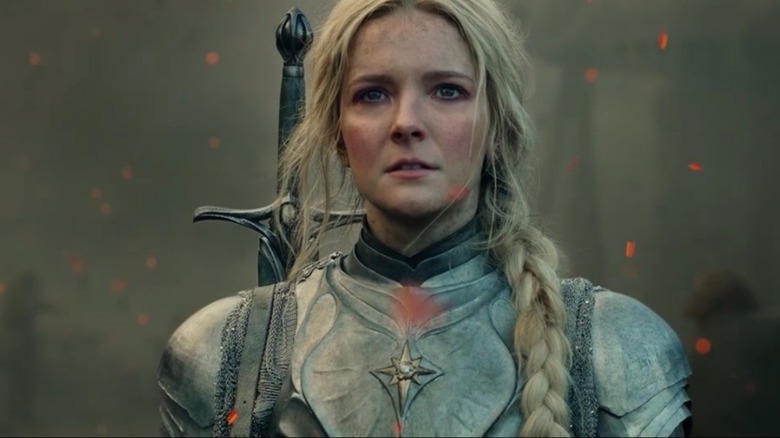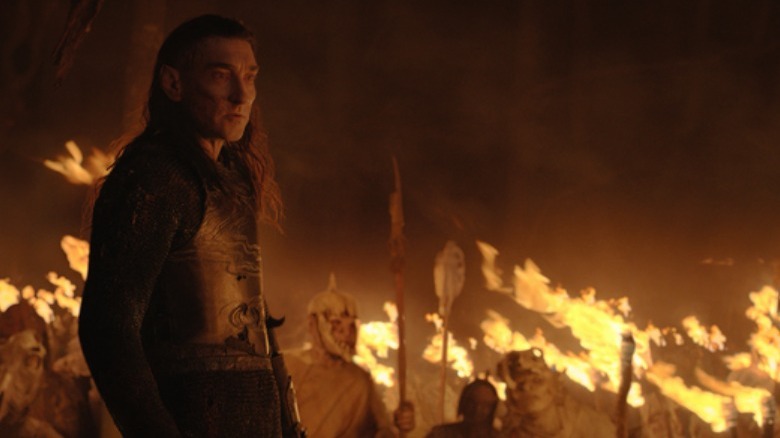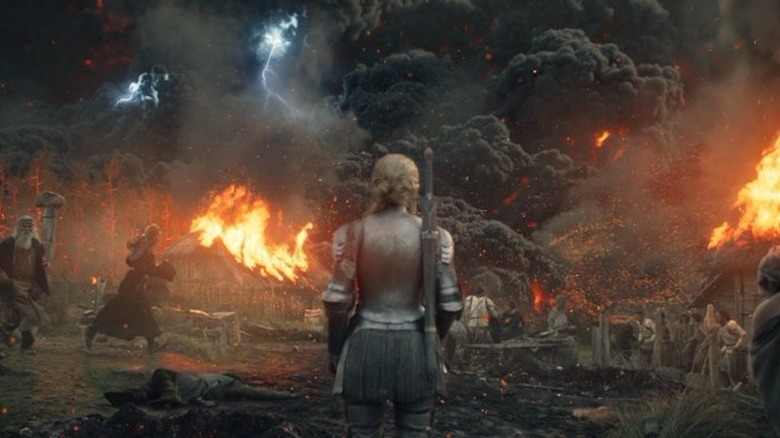The Real-Life Tragedy That Inspired The Rings Of Power's Explosive Episode 6 Finale [Exclusive]
It seems like it was just yesterday that the harfoots were singing while they hiked, and today, Mount Doom is exploding in the faces of our elven heroes. No matter how much educated prognostication Tolkein fans did ahead of this week's episode of "The Lord of the Rings: The Rings of Power," nothing could've prepared viewers for the last five minutes of "Udûn." That is, of course, by design, as the volcanic explosion that blindsided warrior-mode Galadriel (Morfydd Clark) and the people of the village caught in its crosshairs.
It's easy to guess where the writers and filmmakers behind "The Rings of Power" got inspiration for this surprise natural(ish) disaster, yet hearing about it is nonetheless sobering. During an interview with /Film's Vanessa Armstrong, series VFX producer Ron Ames explained that the scene was designed after the explosion at Pompeii, a real-life tragedy that took place in Italy in 79 AD. That disaster, caused by the unexpected eruption of Mount Vesuvius, led to the instant burying of the ancient city and all its inhabitants, who were preserved in volcanic ash.
The Pompeii disaster inspired this week's final scene
"It was a really complex plan — how do you tell the story of what is really a cataclysmic environmental challenge?" Ames says of plotting out the impressive final sequence. "So what we did was we started with the real — we looked at photographs and movies, went back to Pompeii, looked at what happened, and read about what it really looks like." In the episode, the disaster is prompted by Waldreg (Geoff Morrell), who shoves the dark sword we've been wondering about since the first episode into a watchtower stone, causing the local dams to flood.
A moment later, spurts of water begin bursting up from the ground beneath the village like bombs, followed quickly by a flood that activates the previously dormant Mount Doom. Before the credits roll, fireballs have rained down on the village, and Galadriel has been fully engulfed in ash. There's also what looks like a sort of sonic burst, a disruption of the air that knocks everyone off kilter. It sounds like several aspects of the harrowing scene came from the crew's studies of the real-life Pompeii disaster and other volcanic activity.
"Could this physically happen?" Ames asks. "And the answer is yes, it could." He explains that the effects team used location photography of the cliffside and waterfall in order to render the scene's visuals, and built an underground set that they then scanned to create the flooding shots. Ames also explains exactly what we were seeing just before the eruption, saying, "As the cold water rushes into the interior of the volcano creating a temperature differential, it's just magnificent, almost like an atomic bomb explosion."
Let's pretend to be volcanologists for a second
According to Wired, real-life phreatic eruptions are those that take place when volcanoes come into contact with even a small amount of water, causing a steam-based explosion. These types of eruptions can cause an explosion of water, ash, steam, and rocky projectiles, but don't always involve much flowing magma, per Wired and the U.S. Geological Survey. The Mount Doom visuals look to my untrained eye like they could indicate a phreatic eruption, but even if it is, that doesn't necessarily mean our heroes are safe. Although this type of eruption may seem less instantly devastating than Vesuvius' Plinian eruption, it can still unleash toxic gases, and sometimes serves as a precursor to the main event, as with the 1980 eruption of Mount St. Helens.
The Pompeii comparisons and the look of this volcano certainly make me nervous for next week's episode of "The Rings of Power," but as Ames points out, the show did a great job leaving its deadliest threat in plain sight. "You see that mountain in the background, not knowing that it is going to eventually pay itself off," he says. "We never make a big deal of it, but you see it back there and then eventually it has a large part in our story." It's certainly a big deal now, but we'll have to wait to see how Mount Doom's explosive introduction plays into the rest of the series.


